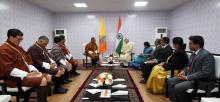It’s not often that a remote village finds a mention in government tourism brochures. Khonoma in Nagaland does. The village is not exactly an archetypal exotic destination. You have to withstand a two-hour, bone-rattling bus trip from Kohima to get there. But it’s a trip worth taking if you are a wildlife enthusiast.
For Khonoma is the site of a unique conservation endeavour: the Khonoma Nature Conservation and Tragopan sanctuary. The 70 sq km reserve is the fruit of a predominantly local initiative to preserve the endangered pheasant, the Blyth’s Tragopan.
Getting to the village could be a bit of a bother. The place is about 20 kilometres southwest of Kohima. For about four of those kilometres, the road runs smoothly, since this is National Highway Number 39.
But once you are off to the “unmetalled” roads that lead to the hills, your vehicle must negotiate slushy roads and treacherous landslips. It’s best, the villagers say, to take one of the jalopies that connect the hill communities with each other.
But at Khonoma you are surely to be well provided for. The Khonoma Tourism Development Board, run by the village’s residents, offers various packages. The sanctuary is ideal for trekking and research work. It has a variety of ecosystems ranging from semi evergreen forest to savanna grasslands. There are camping sites in the reserve.
The origins
 Conservation had little place in people’s lives in 1994, when the Guwahati-based NGO Destination North East first visited the place to do a pilot study related to conservation.
Conservation had little place in people’s lives in 1994, when the Guwahati-based NGO Destination North East first visited the place to do a pilot study related to conservation.
“Things have changed tremendously When we visited the village in 1994, the residents threw a lavish feast. On the platter were monkeys and endangered deer varieties,” remembers Pankaj Gogoi, a researcher with the NGO.
Very soon several environmental organizations such as the Centre for Environment Education (CEE) also started working there.
A year later, Khonoma’s residents were into wildlife conservation.

Much of the change that came about had to do with the awareness programmes by the different environment groups. But the real impetus came from the village council. Customary laws came to the aid of the conservation effort.
In 1998, the council passed strictures to regulate hunting in 70 sq km of forests near Khonoma. Limited hunting of crop-destroyers like wild boars and deer was allowed. The village council banned the sale of wild meat. Violators were fined Rs 3,000.
There was a further deterrent: clans of the defaulters also faced the prospect of fines. All this meant that the villagers complied with the council’s strictures. Hunting was completely banned in 2000.
In 2003, the Khonoma Tourism Development Board was constituted. The agency encourages youths and women in the village to work as tourist guides, tour operators, and interpreters. It also provides equipment to wildlife wardens.
The same year, the Union Ministry of Tourism and Culture adopted the village under its Green Village Project. Khonoma got a circular road and solar lights.
But has the community benefited from the endeavour? Opinions vary. “Benefits have only been at the individual level. Payments are made to guides, to performers at cultural programmes and to individual families but the village as a whole has not benefited much,” says Kevichulie Meyase, a member of the Khonoma Tourism Development Board.
A study under the National Foundation for India (NFI) media fellowship points out that the Khonoma model can be a huge success not only in Nagaland but in the entire North East in terms of tourism.
“The experiment has been a success and Khonoma can become a role model,” says Firoz Ahmed of Aaranyak, a Guwahati-based conservation organisation.






Add new comment